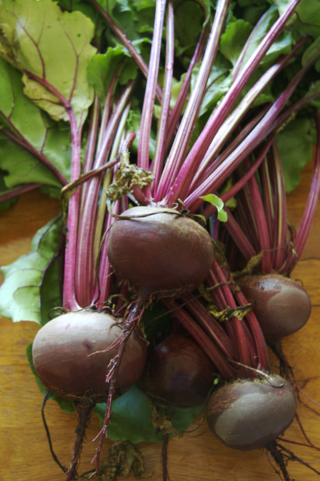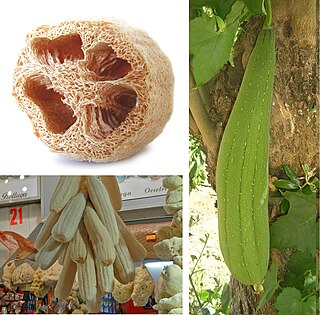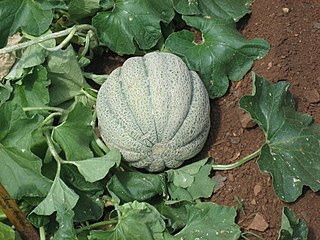
The Cucurbitaceae, also called cucurbits or the gourd family, are a plant family consisting of about 965 species in around 95 genera. Those most important to humans are the following:

Cabbage, comprising several cultivars of Brassica oleracea, is a leafy green, red (purple), or white biennial plant grown as an annual vegetable crop for its dense-leaved heads. It is descended from the wild cabbage, and belongs to the "cole crops" or brassicas, meaning it is closely related to broccoli and cauliflower ; Brussels sprouts ; and Savoy cabbage.

The cantaloupe is a type of true melon from the family Cucurbitaceae. Originally, cantaloupe referred only to the non-netted, orange-fleshed melons of Europe, but today may refer to any orange-fleshed melon of the C. melo species, including the netted muskmelon which is called cantaloupe in North America, rockmelon in Australia and New Zealand, and spanspek in Southern Africa. Cantaloupes range in mass from 0.5 to 5 kilograms.

Emmer wheat or hulled wheat is a type of awned wheat. Emmer is a tetraploid. The domesticated types are Triticum turgidum subsp. dicoccum and T. t. conv. durum. The wild plant is called T. t. subsp. dicoccoides. The principal difference between the wild and the domestic forms is that the ripened seed head of the wild plant shatters and scatters the seed onto the ground, while in the domesticated emmer, the seed head remains intact, thus making it easier for humans to harvest the grain.

The cucumber is a widely-cultivated creeping vine plant in the family Cucurbitaceae that bears cylindrical to spherical fruits, which are used as culinary vegetables. Considered an annual plant, there are three main types of cucumber—slicing, pickling, and seedless—within which several cultivars have been created. The cucumber originates in Asia extending from India, Nepal, Bangladesh, China, and Northern Thailand, but now grows on most continents, and many different types of cucumber are grown commercially and traded on the global market. In North America, the term wild cucumber refers to plants in the genera Echinocystis and Marah, though the two are not closely related.

A melon is any of various plants of the family Cucurbitaceae with sweet, edible, and fleshy fruit. The word "melon" can refer to either the plant or specifically to the fruit. Botanically, a melon is a kind of berry, specifically a "pepo". The word melon derives from Latin melopepo, which is the latinization of the Greek μηλοπέπων (mēlopepōn), meaning "melon", itself a compound of μῆλον (mēlon), "apple", treefruit " and πέπων (pepōn), amongst others "a kind of gourd or melon". Many different cultivars have been produced, particularly of cantaloupes.

The beetroot is the taproot portion of a beet plant, usually known in North America as beets while the vegetable is referred to as beetroot in British English, and also known as the table beet, garden beet, red beet, dinner beet or golden beet.

Pomology is a branch of botany that studies fruits and their cultivation. Someone who researches and practices the science of pomology is called a pomologist. The term fruticulture is also used to describe the agricultural practice of growing fruits in orchards.

Citrullus colocynthis, with many common names including Abu Jahl's melon,colocynth, bitter apple, bitter cucumber, egusi, vine of Sodom, or wild gourd, is a desert viny plant native to the Mediterranean Basin and Asia, especially the Region of Palestine, Turkey, and Nubia.

Pickling is the process of preserving or extending the shelf life of food by either anaerobic fermentation in brine or immersion in vinegar. The pickling procedure typically affects the food's texture and flavor. The resulting food is called a pickle, or, if named, the name is prefaced with the word, 'pickled'. Foods that are pickled include vegetables, fruits, mushrooms, meats, fish, dairy and eggs.

Trichosanthes cucumerina is a tropical or subtropical vine. Its variety T. cucumerina var. anguina raised for its strikingly long fruit. In Asia, it is eaten immature as a vegetable much like the summer squash and in Africa, the reddish pulp of mature snake gourd is used as an economical substitute for tomato. Common names for the cultivated variety include snake gourd, serpent gourd, chichindapadwal and Snake Tomato.

Solanum muricatum is a species of evergreen shrub native to South America and grown for its sweet edible fruit.

Melothria scabra, commonly known as the cucamelon, Mexican miniature watermelon, Mexican sour cucumber, Mexican sour gherkin, mouse melon, or pepquinos, is a species of flowering plant in the cucurbit family grown for its edible fruit. Its native range spans Mexico to Venezuela. Cucumis melo Agrestis and Cucumis callosus is cultivated as Chibber Fruit or Kachri in South Asia and can also grow as weed. Fruits are about the size of grapes and taste like cucumbers with a tinge of sourness. It may have been eaten by indigenous peoples before the European colonization of the Americas began.

Luffa aegyptiaca, the sponge gourd, Egyptian cucumber or Vietnamese luffa, is an annual species of vine cultivated for its fruit, native to South and Southeast Asia.

Cucurbitacins are a class of biochemical compounds that some plants – notably members of the pumpkin and gourd family, Cucurbitaceae – produce and which function as a defense against herbivores. Cucurbitacins and their derivatives have also been found in many other plant families, in some mushrooms and even in some marine mollusks.

Cucumis melo, also known as melon, is a species of Cucumis that has been developed into many cultivated varieties. The fruit is a pepo. The flesh is either sweet or bland, with or without a musky aroma, and the rind can be smooth, ribbed, wrinkled, or netted. In North America, the sweet-flesh varieties are often collectively called muskmelon, including the musky netted-rind varieties and the inodorous smooth-rind varieties, and cantaloupe usually refers to the former type. However, muskmelon in a narrow sense only refers to the musky netted-rind type, also known as North American cantaloupe, while the true cantaloupe is the European type with ribbed and often warty rind that is seldom grown in North America.
Kil'ayim are the prohibitions in Jewish law which proscribe the planting of certain mixtures of seeds, grafting, the mixing of plants in vineyards, the crossbreeding of animals, the formation of a team in which different kinds of animals work together, and the mixing of wool with linen in garments.

The oriental melon, is a group of Cucumis melo cultivars that are produced in East Asia. Phylogenetic studies tracing the genetic lineage of the plant suggest that it may have originated in eastern India, having then spread to China over the Silk Road, from which it was introduced to Korea and Japan. Its flavour has been described as a cross between a honeydew melon and a cucumber. It is noticeably less sweet than Western varieties of melon, and consists of about 90% water. The fruits are commonly eaten fresh; with its thin rind and small seeds, the melon can be eaten whole.

The carosello is a landrace variety of melon found in Southern Italy. It is common in the Apulia region of Italy.




















